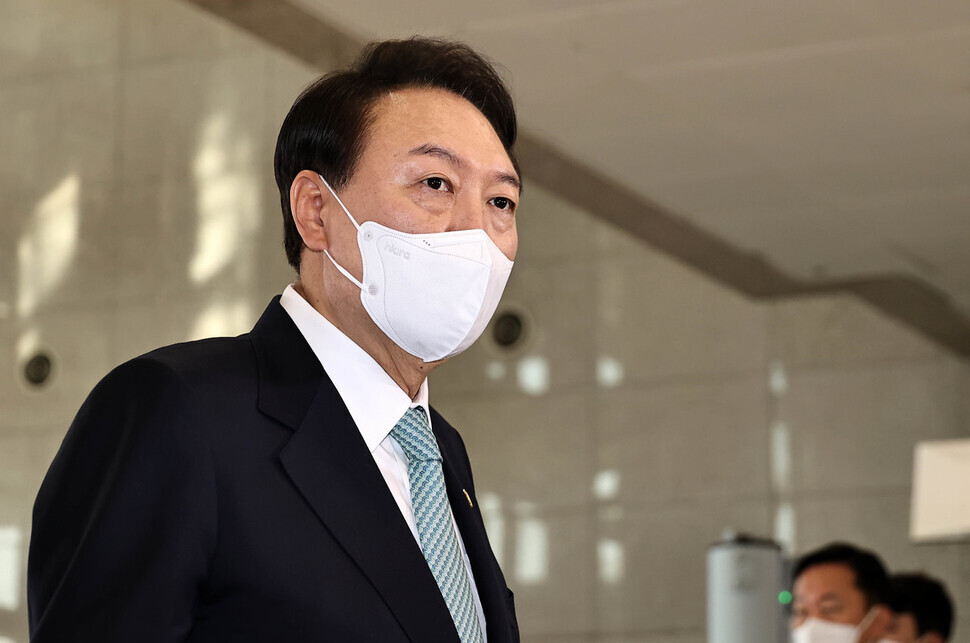hankyoreh
Links to other country sites 다른 나라 사이트 링크
S. Korean administration shifts focus from nuclear rearmament to US strategic assets

President Yoon Suk-yeol shared brief comments Thursday about possible measures for countering North Korea’s escalating nuclear and missile threats. “There are various opinions about extended deterrence both in South Korea and the US, and we are carefully listening and meticulously considering different possibilities,” Yoon said.
The Ministry of National Defense and the Ministry of Foreign Affairs also announced that they are currently in talks with the US concerning a plan to deploy US strategic assets to the Korean Peninsula in a timely manner.
The focus seems to be more on strengthening the US nuclear umbrella rather than relocating US tactical nuclear weapons to the peninsula, the latter having mainly been floated by the ruling party.
Yoon made the remarks on his way to the presidential office in Yongsan on Thursday, when journalists asked him about reports that South Korea asked the US for a nuclear sharing arrangement.
The Chosun Ilbo newspaper reported that the South Korean government had asked the US to strengthen its nuclear deterrence on the peninsula by sharing US tactical nuclear weapons in the event of a seventh nuclear test by North Korea. The report also said the two sides were discussing ways to deploy nuclear-powered aircraft carriers or nuclear-powered submarines to the waters around the Korean Peninsula at all times.
Yoon’s response can be interpreted as the South Korean government currently considering different ways of strengthening extended deterrence, a framework in which the US provides its allies with nuclear deterrence support in case of a threat.
“We are consulting, debating, and devising all means and measures to significantly strengthen the extended deterrence,” one key presidential office official told reporters. The official also said that the regular deployment of nuclear-powered carriers and nuclear submarines could be “one of the concrete measures” that could be adopted.
Vice Defense Minister Shin Beom-chul clarified the government’s plans with comments of his own.
“Rather than redeploying tactical nuclear weapons, the most desirable way to deter North Korea would be by deploying currently available US strategic assets to the Korean Peninsula in a timely and coordinated manner,” Shin said in a radio interview with SBS.
“There are in-depth discussions taking place between South Korea and the US at that level,” Shin added.
Redeploying tactical nuclear weapons, which were withdrawn from South Korea in 1991, would void any calls for “denuclearization of the Korean Peninsula” and would also require overcoming US opposition. Given these issues, the South Korean government seems to be considering more realistic options such as the regular deployment of US strategic assets to the peninsula.
Previously, ruling party officials, including People Power Party interim leader Chung Jin-suk, made various extreme remarks, including calling for the 1991 Korean denuclearization declaration to be scrapped and for US tactical nuclear weapons to be brought back to South Korea.
Yoon, however, has neither confirmed nor denied the possible relocation of US tactical nuclear weapons to South Korean territory. Instead, the president has maintained an ambiguous attitude while key figures in his ruling party have been making risky and unrealistic remarks, further adding fuel to the fire in this wasteful controversy.
“The tactical nuclear redeployment brought up by the ruling party is not a well-thought-out decision,” Cheong Seong-chang, director of the Center for North Korean Studies at the Sejong Institute, told the Hankyoreh. “It is a misjudgment which has been caused by excessive trust in the US since [South Korea] has long been relying on extended deterrence from the US,” Cheong said.
Meanwhile, North Korea continued its successive provocations on Wednesday, by firing two long-range cruise missiles involving units operating tactical nuclear weapons. The test was conducted under the guidance of leader Kim Jong-un.
Kim called Wednesday’s tests “another clear and unequivocal warning by the country to its enemies,” according to North Korea’s Korean Central News Agency.
By Kim Mi-na, staff reporter; Bae Ji-hyun, staff reporter
Please direct questions or comments to [english@hani.co.kr]

Editorial・opinion
![[Editorial] Penalties for airing allegations against Korea’s first lady endanger free press [Editorial] Penalties for airing allegations against Korea’s first lady endanger free press](https://flexible.img.hani.co.kr/flexible/normal/500/300/imgdb/original/2024/0502/1817146398095106.jpg) [Editorial] Penalties for airing allegations against Korea’s first lady endanger free press
[Editorial] Penalties for airing allegations against Korea’s first lady endanger free press![[Editorial] Yoon must halt procurement of SM-3 interceptor missiles [Editorial] Yoon must halt procurement of SM-3 interceptor missiles](https://flexible.img.hani.co.kr/flexible/normal/500/300/imgdb/child/2024/0501/17145495551605_1717145495195344.jpg) [Editorial] Yoon must halt procurement of SM-3 interceptor missiles
[Editorial] Yoon must halt procurement of SM-3 interceptor missiles- [Guest essay] Maybe Korea’s rapid population decline is an opportunity, not a crisis
- [Column] Can Yoon steer diplomacy with Russia, China back on track?
- [Column] Season 2 of special prosecutor probe may be coming to Korea soon
- [Column] Park Geun-hye déjà vu in Yoon Suk-yeol
- [Editorial] New weight of N. Korea’s nuclear threats makes dialogue all the more urgent
- [Guest essay] The real reason Korea’s new right wants to dub Rhee a founding father
- [Column] ‘Choson’: Is it time we start referring to N. Korea in its own terms?
- [Editorial] Japan’s rewriting of history with Korea has gone too far
Most viewed articles
- 160% of young Koreans see no need to have kids after marriage
- 2[Editorial] Penalties for airing allegations against Korea’s first lady endanger free press
- 3Presidential office warns of veto in response to opposition passing special counsel probe act
- 4Hybe-Ador dispute shines light on pervasive issues behind K-pop’s tidy facade
- 5Months and months of overdue wages are pushing migrant workers in Korea into debt
- 6Japan says it’s not pressuring Naver to sell Line, but Korean insiders say otherwise
- 7S. Korea “monitoring developments” after report of secret Chinese police station in Seoul
- 8OECD upgrades Korea’s growth forecast from 2.2% to 2.6%
- 9[Reporter’s notebook] In Min’s world, she’s the artist — and NewJeans is her art
- 10[Guest essay] Maybe Korea’s rapid population decline is an opportunity, not a crisis